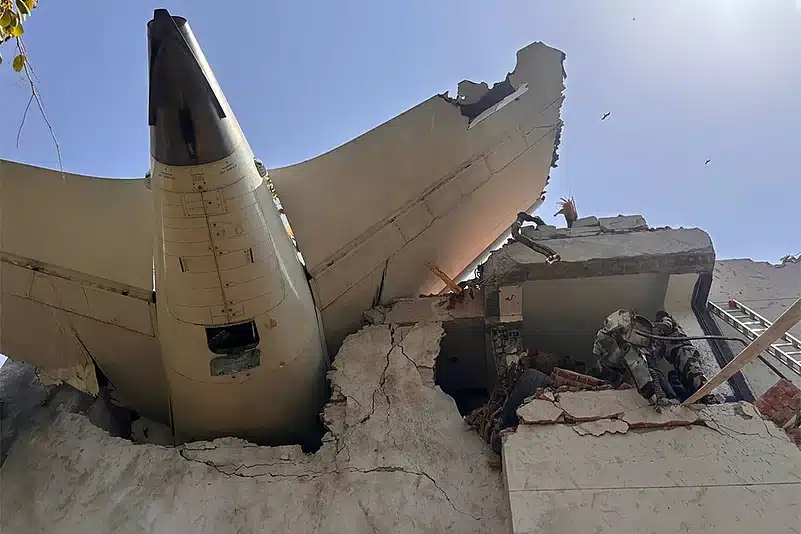Cockpit Recordings Raise New Questions in Flight 171 Tragedy

Investigators have made a startling revelation in the preliminary inquiry into the tragic crash of Air India Flight 171, which claimed the lives of 260 people in June. Just moments after takeoff, the fuel-control switches of the Boeing 787 Dreamliner unexpectedly shifted to the “cut-off” position, cutting off fuel supply to the engines and resulting in a complete power failure. The cockpit voice recordings reveal a perplexing exchange between the pilots, raising critical questions about the circumstances surrounding this devastating incident.
Details of the Crash
Air India Flight 171 took off from Ahmedabad and was airborne for less than 40 seconds before crashing into a densely populated area of the city. The aircraft, a 12-year-old Boeing 787 Dreamliner, reached an altitude of 625 feet in clear weather before losing all location data approximately 50 seconds into the flight, according to Flightradar24. The preliminary report, spanning 15 pages, provides initial insights into the crash, with investigators meticulously examining the wreckage and cockpit recorders to determine the cause of the disaster.
The cockpit voice recording captures a moment of confusion, with one pilot questioning why the fuel switches were turned off, to which the other pilot responded that he did not do it. At the time of the incident, the co-pilot was at the controls while the captain monitored the situation. The switches were later returned to their normal position, which initiated an automatic engine relight. However, by the time of the crash, one engine was regaining thrust while the other had relit but had not yet achieved full power.
Investigative Findings
The investigation is being led by Indian authorities, with contributions from experts at Boeing, GE, Air India, and Indian regulators, as well as representatives from the US National Transportation Safety Board and the UK. A significant focus of the inquiry is the fuel-control switches, which are designed to prevent accidental activation. These switches require a specific action to unlock before they can be flipped, a safety feature that has been in place since the 1950s. Experts have noted that it would be nearly impossible to accidentally activate both switches simultaneously, raising questions about the actions taken by the pilots.
Shawn Pruchnicki, a former airline accident investigator, emphasized the need to understand whether the switch activation was intentional or a result of confusion. He pointed out that pilots typically do not make such errors without a clear indication of a problem. The cockpit voice recorder is expected to provide crucial insights, as investigators seek to identify the voices of the pilots involved in the incident.
Potential Causes and Concerns
The investigation has also highlighted concerns regarding the fuel control switches. In December 2018, the US Federal Aviation Administration issued a Special Airworthiness Information Bulletin (SAIB) regarding certain Boeing 737 fuel control switches, noting that some were installed with the locking feature disengaged. Although this issue was acknowledged, it was not classified as unsafe enough to warrant an Airworthiness Directive. The same switch design is used in the Boeing 787-8 aircraft, including the one involved in the crash, leading to questions about whether Air India should have conducted the recommended inspections.
Experts are now examining whether the fuel control switches could have been triggered electronically by the aircraft’s electronic control unit without pilot intervention. This possibility raises significant safety concerns. Meanwhile, fuel samples from the refueling tanks have been deemed satisfactory, and mechanical failure has been ruled out for the time being, pending further investigation.
Final Moments and Crew Response
As the investigation continues, details about the final moments of Flight 171 are emerging. The deployment of the Ram Air Turbine (RAT), which serves as an emergency backup generator, indicates a severe systems failure. The landing gear was found in the “down position,” suggesting that the pilots did not have adequate time to retract it during the emergency.
Witness accounts from experienced pilots suggest that in such critical situations, the focus shifts entirely to maintaining control of the aircraft rather than procedural tasks like retracting the landing gear. Investigators believe the crew attempted to recover the situation, but the sequence of events unfolded too rapidly for effective action. Ultimately, the combination of engine failures and the pilots’ response time contributed to the tragic outcome of this aviation disaster.
Observer Voice is the one stop site for National, International news, Sports, Editor’s Choice, Art/culture contents, Quotes and much more. We also cover historical contents. Historical contents includes World History, Indian History, and what happened today. The website also covers Entertainment across the India and World.
Follow Us on Twitter, Instagram, Facebook, & LinkedIn

